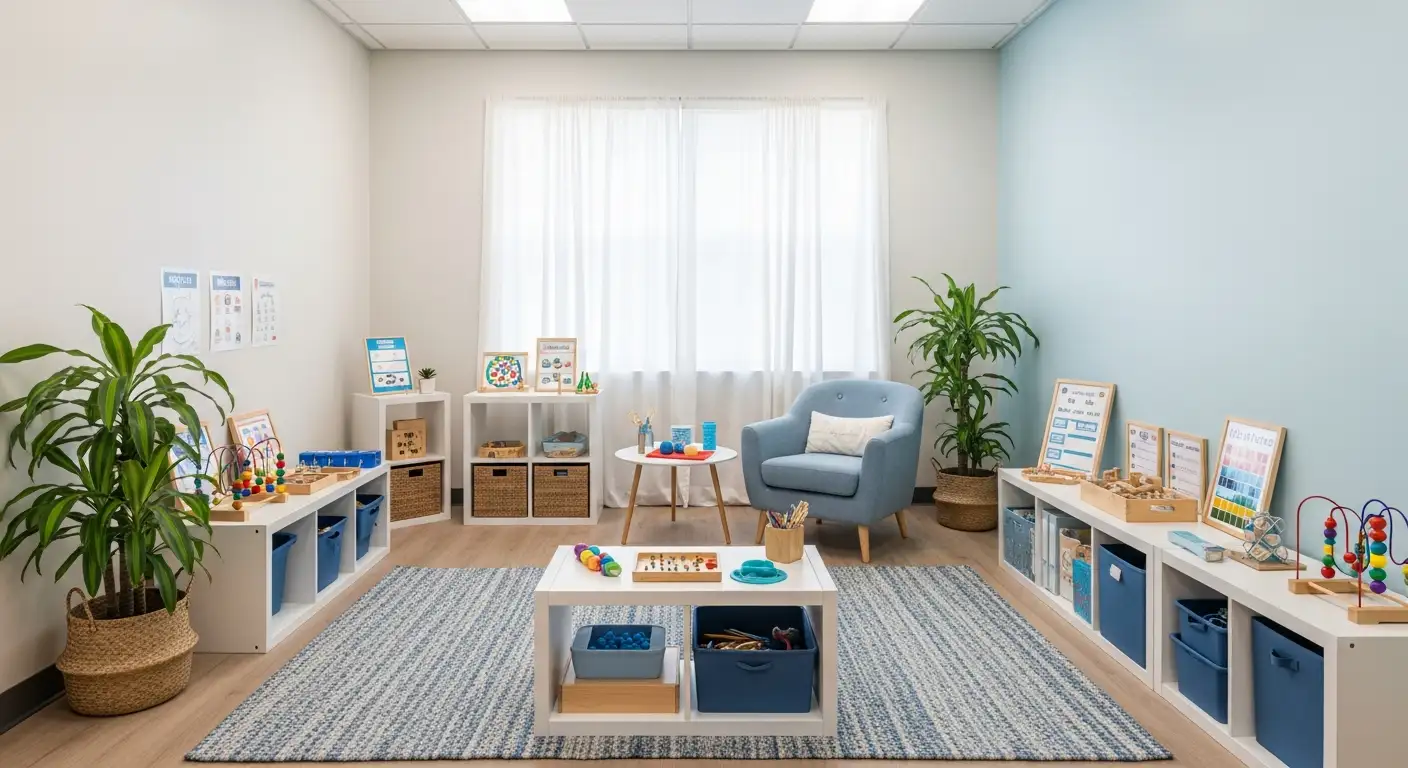Understanding the Power of Group Settings for Autism Therapy
Group therapy has emerged as a vital approach in supporting children with autism spectrum disorder (ASD). Beyond individual treatments, group-based social skills interventions foster environments where children can develop critical communication, social, and emotional skills alongside peers facing similar challenges. This article explores the multifaceted benefits of group therapy for children with autism, highlighting its effectiveness, mechanisms, and role in enhancing overall well-being.
Comprehensive Benefits of Group Therapy for Children with Autism
How does group therapy foster a sense of community and mutual support?
Group therapy creates a supportive environment where children with autism can connect with peers facing similar challenges. This shared experience helps children realize they are not alone in their struggles, reducing feelings of isolation. Participating in group activities like art, role-play, and cooperative games encourages mutual understanding and emotional connection, fostering a sense of belonging.
How does group therapy encourage and motivate children to improve?
Presence of peers acts as an motivating factor, inspiring children to engage actively and try new social behaviors. When children see their peers succeed and participate, they often feel encouraged to improve their own social skills. Group settings also include fun, interactive activities which promote enjoyment and sustained participation.
In what ways does group therapy enhance social and interpersonal skills?
Through structured activities such as role-playing, social stories, and cooperative games, children practice real-world social interactions in a safe environment. These activities improve communication, eye contact, imitation, and joint attention. The structured setting allows children to generalize these skills to everyday settings like school and community.
How does group therapy promote emotional healing and skill development?
Children learn to express their emotions through art, music, and movement, building emotional awareness. The collaborative nature of group therapy helps foster trust, cooperation, and empathy among children. Trained therapists guide children in developing foundational social skills, self-regulation, and emotional resilience, which are essential for adapting to social environments.
| Aspect | Benefits | Examples of Activities |
|---|---|---|
| Sense of community and mutual support | Reduces loneliness, increases feelings of acceptance | Group art projects, shared storytelling |
| Encouragement and motivation | Boosts engagement, fosters perseverance | Peer encouragement during role-playing |
| Improvement of social skills | Enhances communication, cooperation, and social understanding | Cooperative games, social stories |
| Emotional and skill growth | Facilitates emotional awareness and everyday functioning skills | Art therapy, rhythmic movement, sensory activities |
Studies underscore that integrating group therapy with individual strategies like ABA can significantly boost social skills development. Notably, peer interactions increase motivation, leading to meaningful improvements in social competence and emotional well-being for children with autism.
The Effectiveness of Group Therapy in Developing Social Skills in Children with Autism

How effective is group therapy for children?
Group therapy is a widely used approach to help children with autism develop essential social skills. It creates a structured environment where kids can practice interacting with peers, which can translate to real-world settings like school and community.
Research shows that group therapy can lead to improvements in social behaviors such as eye contact, imitation, and joint attention. These sessions often include activities like role-playing, cooperative games, and art therapy, which make learning engaging and practical.
Studies indicate that children benefit not only from practicing skills but also from the supportive peer environment. Children feel validated and connected, boosting their motivation and emotional well-being.
Impact on social knowledge and social performance
Meta-analyses reveal that group social skills interventions (GSSIs) have a medium overall effect size (g = 0.51). This means they generally produce modest benefits across diverse measures. Within these interventions, improvements in social knowledge tend to be large (g = 0.92), mainly reflecting increased understanding of social cues and norms.
However, gains in actual social performance, such as interaction skills in everyday situations, tend to be smaller and vary depending on the assessment method. For instance, parent and observer reports show small effects (g = 0.47 and 0.40 respectively), whereas task-based measures—assessing specific social skills through structured tasks—show a medium effect (g = 0.58).
Interestingly, self-reports from children often show large effects (g = 0.92), but these are largely attributable to increased social knowledge rather than significant changes in real-life behavior.
Evidence from research and meta-analyses
Research highlights the complex nature of evaluating social skill interventions. Different sources of assessment, including parents, teachers, self, observers, and objective tasks, provide varying perspectives. While self-report data suggest notable gains, teacher reports are not consistently significant (g = 0.41, p = 0.11), underscoring that perceived improvements may differ from observed behaviors.
Some evidence points to publication bias potentially inflating success estimates, urging cautious interpretation. Nonetheless, combining multiple assessment types offers a comprehensive picture of progress.
Comparison with other therapeutic approaches
Group therapy often complements other interventions like Applied Behavior Analysis (ABA). ABA, recognized for its scientific validation, enhances behaviors such as social communication and adaptive skills.
While individual ABA therapy provides high customization and rapid progress—especially for children with severe challenges—group ABA emphasizes social interaction through peer modeling and naturalistic settings. Combining both approaches can yield well-rounded improvements.
Group therapy's unique value lies in fostering a sense of community, allowing children to practice skills in a safe environment facilitated by trained therapists. Activities like art, role-play, and cooperative tasks help build trust, promote spontaneous interaction, and reinforce social learning.
In summary, group therapy is an effective and valuable modality for increasing social knowledge and performance in children with autism. Its benefits are most evident when integrated with other evidence-based treatments like ABA, providing a comprehensive strategy for social development.
Techniques and Approaches in Group Therapy for Autism
What are the specific approaches and mechanisms of group therapy for autism?
Group therapy for children with autism employs a variety of methods focused on sensory-motor experiences and creative techniques. These approaches aim to improve perceptual awareness and social understanding through engaging, nonverbal activities.
One of the core strategies involves sensory-motor activities, such as drawing, movement exercises with props, and musical accompaniment. These activities help children become more aware of their own bodies and develop a better understanding of others, laying the groundwork for social skills like eye contact, imitation, and joint attention.
The use of nonverbal expression is a key component. Children often participate in creative arts and movement-based activities that foster spontaneous social interactions. These activities are designed to promote embodied relational experiences—meaning children are encouraged to connect through physical activity and sensory input rather than solely through words.
Physical props play a significant role in facilitating movement, coordination, and emotional regulation. For example, stretch bands can be used to encourage cooperation and body awareness, while rhythmic movements and visual arts support sensory integration.
The process of group therapy typically involves phases where children start with disorganization, experiencing some chaos or discomfort, but gradually, as trust and cooperation develop, they form stronger connections with peers and therapists. This process builds a foundation for developing social behaviors such as mutual eye contact, imitation, and reciprocal play.
Spontaneity is highly emphasized, encouraging children to explore and express themselves freely within a structured environment. This approach fosters trust, patience, and emotional safety, making it easier for children to learn and practice social skills effectively.
Overall, the target mechanisms of this therapeutic approach include enhancing sensory-motor integration, promoting self-other awareness, and creating engaging environments where children can practice social interactions through embodied, multimodal activities—ultimately supporting their ability to navigate social landscapes more confidently.
Role of Peer Modeling and Social Interaction in Therapy Outcomes

Why is group therapy beneficial for children with autism?
Group therapy offers children with autism a unique space to develop essential social and communication skills with peers who face similar challenges. This shared environment helps reduce feelings of isolation while promoting interaction and mutual understanding.
Activities like music therapy, art projects, role-playing, and sensory-motor exercises are used within group settings to enhance motor coordination and sensory integration. These engaging activities not only develop perceptual awareness but also foster spontaneous social behaviors such as eye contact, imitation, and joint attention.
Involving caregivers in group therapy sessions allows for reinforcement of skills at home, increasing consistency and generalization of learned behaviors. Participating in supportive peer environments can significantly improve confidence, social awareness, and emotional regulation, which are crucial for daily life.
Moreover, group settings encourage naturalistic interactions that mirror real-world social environments, making learned skills more transferable. Children learn by observing and imitating peers, which enhances their motivation and engagement in social exchanges.
How does peer influence on motivation and observational learning enhance therapy?
Peers play a vital role in motivating children with autism to participate actively in therapy. Seeing peers successfully engaging in social activities inspires children to try their own interactions and practice new skills.
Observational learning is a powerful mechanism in group therapy. Children watch their peers demonstrate appropriate social behaviors, like sharing, turn-taking, and responding to social cues. This modeling provides clear examples that children can imitate, facilitating skill acquisition in a natural and enjoyable way.
How do group activities foster spontaneous social behaviors?
Activities designed for group therapy are often interactive and fun, such as cooperative games, arts and crafts, or movement activities using props like stretch bands and musical instruments. These activities encourage children to interact spontaneously, promoting reciprocity and social reciprocity.
Through these activities, children learn to navigate social cues, express emotions nonverbally, and build trust among peers. The structure of these activities often involves phases of disorganization, where initial chaos gives way to increasing connectedness, leading to more cohesive social interactions.
Such spontaneous behaviors lay the foundation for meaningful social relationships and adaptive social skills. The group environment thus acts as a training ground where children can safely practice and refine their social abilities, which can be transferred to their daily social life.
Emotional Regulation and Behavioral Improvements through Group Activities

How does group therapy aid in emotional regulation and behavioral improvements?
Group therapy incorporates various physical and rhythmic activities, such as music, movement, and art, to help children with autism regulate their emotions. These activities act as sensory-motor tools that support self-awareness and emotional control. For example, rhythmic movement and auditory stimuli like musical accompaniment encourage children to connect with their bodies and feelings, fostering a sense of calm and focus.
Engaging in these embodied experiences allows children to practice self-control in a safe environment. As they participate in cooperative tasks — such as drawing, role-playing, or using props like stretch bands — children learn to manage their impulses and emotional responses. This process helps reduce anxiety and behavioral outbursts, which are common challenges for children on the autism spectrum.
The structured yet playful nature of group activities fosters trust and cooperation among participants. Over time, children develop greater emotional awareness and better self-regulation skills. These improvements often translate into more positive social interactions outside therapy sessions, including better adaptation to daily routines and social settings.
Moreover, the relational context of group therapy promotes spontaneous social engagement and reciprocity. As children coordinate movements and share artistic expressions, they build connections that reinforce emotional understanding and trust. This gradual development of emotional regulation not only enhances individual well-being but also supports smoother integration into school, family, and community environments.
In summary, group therapy's combination of sensory-motor activities and social interaction plays a crucial role in helping children with autism gain control over their emotions and behavior. Such experiences lay a foundation for improving adaptive responses and fostering resilience in everyday life.
| Activity Type | Purpose | Benefit | Examples |
|---|---|---|---|
| Rhythmic movement | Emotional calming | Approaches self-regulation | Dancing, marching, using percussion |
| Art and visual tasks | Expression of feelings | Enhances emotional awareness | Drawing, painting, crafts |
| Use of props | Motor coordination & emotional regulation | Builds trust and body awareness | Stretch bands, musical instruments |
| Group singing | Social bonding and mood regulation | Improves mood and social connection | Singing games, chorus |
This combination of engaging activities makes group therapy a valuable approach for nurturing emotional control and addressing behavioral challenges.
Parental Support and Involvement in Group Therapy
How can parents support their child's progress in group therapy?
Parents play a crucial role in maximizing the benefits of group therapy for children with autism. By working closely with therapists, they can gain a clear understanding of the therapy's goals and strategies. This collaboration ensures that parents reinforce the skills learned during sessions at home, creating a consistent environment for their child.
Reinforcing social skills and behaviors through daily routines and positive feedback helps children apply new skills in real-world settings. Awareness of the activities, goals, and progress discussed in therapy sessions enables parents to support their child's confidence and motivation.
Sharing observations, insights, and concerns with therapists fosters a team approach. This communication allows for adjustment of strategies tailored to the child's unique needs, enhancing developmental outcomes.
Active parental involvement not only promotes skill generalization but also provides emotional support. When parents are engaged, children often feel more secure and motivated to try new social interactions, which can lead to improved social competence overall.
Therapeutic Benefits, Enjoyment, and Long-Term Outcomes

What are the outcomes and advantages of group therapy for children with autism?
Group therapy offers a range of positive results for children with autism. It has been shown to significantly enhance social skills, communication abilities, and emotional regulation. The engaging and playful nature of activities—like games, art projects, and role-playing—helps sustain children's interest and motivation, making therapy sessions enjoyable rather than burdensome.
Shared experiences in this structured setting foster an environment of trust and collaboration. As children work together, they develop bonds, learn to cooperate, and feel a sense of belonging, which can boost their emotional well-being and reduce feelings of isolation.
Therapeutic benefits extend beyond immediate skill acquisition. Children often gain confidence, improve their ability to form peer relationships, and develop social behaviors that can be applied in daily life. These gains tend to support better integration at school, in community activities, and within family settings.
In the long run, children who participate in group therapy tend to show increased resilience and a more positive attitude toward social interactions. They develop greater adaptive behaviors that help them navigate various social environments more effectively. Overall, group therapy contributes to their broader development, promoting independence, social competence, and emotional health.
The Complementary Role of Group Therapy and Other Interventions
How does group therapy complement other therapeutic approaches?
Group therapy plays a valuable role alongside other treatments like Applied Behavior Analysis (ABA). While ABA primarily focuses on structured, individualized interventions to improve skills such as communication and adaptive behavior, group therapy provides a social environment where children can practice these skills in real-time and naturalistic settings.
In group settings, children have opportunities to interact spontaneously with peers, fostering social reciprocity, trust, and emotional connections. Activities such as role-playing, cooperative games, and art projects encourage children to use language, interpret social cues, and develop self-regulation in a supportive atmosphere.
Combining the individualized focus of ABA with the social and emotional benefits of group therapy results in a more well-rounded approach. This integration supports not only behavioral improvements but also helps children generalize skills beyond therapy sessions to everyday situations like school and community activities.
Parents and therapists often work together to reinforce learning at home, making the child's progress more consistent and durable. Overall, the synergy between structured interventions and social experiences enhances confidence and competence in managing social interactions.
Empowering Children Through Supportive Group Environments
Incorporating group therapy into the treatment landscape for children with autism offers numerous advantages, including social, emotional, and behavioral growth. Its interactive and engaging nature not only fosters essential life skills but also provides a sense of community and belonging. When combined with other therapeutic methods like ABA, it creates a well-rounded approach that maximizes development and enhances quality of life. Support from parents, caregivers, and therapists is crucial in sustaining progress and encouraging ongoing social integration. Ultimately, group therapy serves as a vital tool in helping children with autism thrive socially, emotionally, and academically, paving the way for more confident and connected futures.
References
- Efficacy of group social skills interventions for youth with autism ...
- Moving Along and Beyond the Spectrum: Creative Group Therapy ...
- Group vs. Individual ABA Therapy for Children With Autism
- Top Benefits of Group Therapy | Blossom Children's Center
- Group Therapy for Autism: Improve Social Skills
- Speech Group Benefits for Autism Spectrum Disorder
- Group Therapy vs Individual Therapy: Uses, Benefits & Effectiveness










